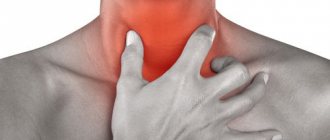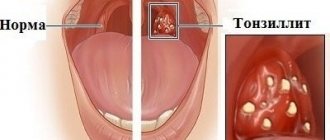How does a lump in the esophagus manifest itself?
A lump in the esophagus is a very unpleasant sensation
A description of this symptom is found in the works of the great ancient physician Hippocrates. He considered a lump in the esophagus to be a manifestation of hysterical natures. Since then, the idea of a coma in the esophagus has changed somewhat. It is characterized by the following signs:
- Difficulty swallowing and breathing.
- Sensation of a foreign body in the area of the esophagus.
- Constant desire to cough, to swallow obstruction.
- Feeling of lack of air, suffocation.
- Fear of suffocation, choking (especially in sleep).
- Hoarseness, pain when talking or eating.
Such sensations are not always permanent; they can manifest themselves after taking a certain body position, or after eating, mental stress, or the appearance of strong emotions.
The influence of nervous tension on the appearance of unpleasant symptoms in the esophagus
If such a symptom appears infrequently and is not associated with food intake, it can be assumed that the lump in the throat is caused by mental characteristics, in particular, a tendency to hysteria. With nervous tension associated with anxiety, excitement, or stress, a sensation of a lump appears closer to the pharynx in the area of the esophagus, which is usually called “hysterical”.
After a short period of time, everything usually goes away without any drug intervention or complications. Subsequently, in such cases, you can do several breathing exercises, massage the collar area, and take a mild sedative. Even a simple change of environment will help get rid of this symptom.
A lump in the esophagus may also be psychogenic in nature
From a physiological point of view, this reaction of the body is explained by the fact that during stress the body needs a large amount of oxygen. In this case, the glottis becomes so wide that it cannot be completely covered by the epiglottis. As a result, it is impossible to utter a word, swallow tears, or take a breath.
If the feeling of a coma in the esophagus is accompanied by panic attacks and mood swings, it is necessary to take sedatives, antidepressants, and consult a psychotherapist. The prerogative of a neurologist will be to treat a lump in the throat if it is accompanied by:
- Dizziness
- Nausea
- Apathy
- Increased sensitivity to weather fluctuations.
In this case, we are talking about vegetative-vascular dystonia, which has recently become the scourge of the modern city dweller. Dysfunction of the nervous system manifests itself in this way. If someone in the esophagus experiences pain between the ribs, which intensifies with exercise, as well as with inhalation and exhalation, we may be talking about intercostal neuralgia - inflammation of the nerve responsible for the innervation of the chest.
Symptom of "coma in the throat"
Murzaeva Irina Yurievna
Endocrinologist, Preventive Medicine Doctor
December 15, 2016
This is one of the most common complaints with which a person comes to an endocrinologist.
A lump in the throat can be described as a non-painful sensation of the presence of a voluminous foreign body in the throat, usually in the area of the jugular fossa, this is a “hollow” between the collarbones.
This may feel like a “tickling” in the throat, a “stuck pill” feeling. This symptom differs from the symptom of dysphagia by the free passage of food through the esophagus without choking or choking.
Essentially this is a neurosis of the pharynx. But to understand this, you need to understand the criteria. According to medical parameters, the symptom of “coma in the throat” is set according to the following Rome III recommendations (provided that the symptoms have been present for at least 3 months, this is not a “one-time action”.
- constant or periodically occurring non-painful sensation of the presence of a voluminous foreign body in the throat;
- the appearance of a lump in the throat between meals;
- lack of evidence that this symptom is caused by gastroesophageal reflux;
- absence of histopathological changes (according to FGDS) that could affect the motility of the esophagus.
“Lump in the throat” is a functional condition (usually associated with stress of the globus hystericus type, and not a disease. To prove this, it is imperative to exclude diseases that are masked under it. And this is:
- esophageal motility disorder;
- head and neck tumors;
- diseases of the thyroid gland with goiter;
- cervical lymphadenoaptia;
- GERD;
- hiatal hernia;
- chronic tonsillitis, pharyngitis or laryngitis;
- esophageal stenosis;
- spondylosis of the cervical spine;
- psychological disorders;
- increased tone of the upper esophageal sphincter.
To diagnose these conditions you need to undergo:
- ENT doctor, sometimes with video endoscopy of the larynx
- FGDS with determination of stomach acidity (ph-metry) followed by consultation with a gastroenterologist
- Ultrasound of the thyroid gland and blood tests for hormones
- consultation with a neurologist
- psychotherapist.
Actually, globus hystericus can be supplemented by other complaints that confirm its psychogenic nature, and these are:
- cardiopalmus
- increased sweating
- loss of appetite
- insomnia
- increased excitability
- irritability.
The concept of dysphagia is qualitatively different from the “coma in the throat” symptom. These are different concepts. Dysphagia is a feeling of stuck solid or liquid food, delay or disruption of its passage through the esophagus. And there are many more reasons that cause this condition and they are more severe. I will give just a few examples. Dysphagia occurs with strokes, multiple sclerosis, myasthenia gravis, butulism (mushroom poisoning), amyloidosis, esophageal diverticula, etc.
These are different concepts. Dysphagia is a feeling of stuck solid or liquid food, delay or disruption of its passage through the esophagus. And there are many more reasons that cause this condition and they are more severe. I will give just a few examples. Dysphagia occurs with strokes, multiple sclerosis, myasthenia gravis, butulism (mushroom poisoning), amyloidosis, esophageal diverticula, etc.
Therefore, dysphagia is divided according to the level of occurrence, which facilitates diagnosis:
- oropharyngeal: cerebral, neuromuscular, mechanical obstruction of food passage and esophageal.
For diagnostic purposes, the doctor can interview the patient using a special medical “Mayo Clinic Dysphagia Questionnaire . On the basis of which it is decided which diagnostic measures to apply in a particular case.
Dysphagia, unlike “a lump in the throat,” is always based on a specific disease.
Treatment depends on the identified cause.
Thyroid problems and esophageal conditions
Pathologies of the thyroid gland associated with its increased or decreased function (hypothyroidism and hyperthyroidism) can cause a feeling of a lump in the esophagus. If, at the same time as this symptom, you experience irritability, a feeling of chilliness, or, conversely, constant sweating, dry and brittle nails, hair, and memory impairment, you may need to consult an endocrinologist. Causes of thyroid dysfunction:
- Hormonal changes in the body.
- Iodine deficiency in food and drinking water.
- Metabolic disorders.
To clarify the diagnosis, you will have to do an ultrasound of the thyroid gland and donate blood for the presence of its hormones.
It is important not to miss other symptoms
The feeling that something is bothering your throat can appear not only with VSD. Therefore, it is important to exclude all other possible causes of this symptom, and only then begin treatment for vegetative-vascular dystonia.
Laryngitis is an inflammation of the throat in the glottis area. Characteristic symptoms of laryngitis are a sore throat, pain when speaking, hoarseness or hoarseness, a dry barking cough, and increased body temperature. The sensation of a foreign body in the throat and soreness during laryngitis is caused by swelling of the glottis. Without proper and timely treatment, swelling can increase dramatically and impair breathing. The diagnosis is confirmed by an otolaryngologist.
In this case of enlargement of the thyroid gland, visible changes are usually observed on the front of the neck (unevenness, bulge or redness), the sensation of a foreign mass in the throat is not associated with emotions or time of day, body weight may change sharply, and the voice becomes rougher over time. An endocrinologist can determine the pathology of the thyroid gland.
Increased stomach acidity and gastroesophageal reflux disease can also cause discomfort in the throat and a feeling of a foreign body. Here the cause will be swelling and spasms that occur in response to the irritating effect of stomach acid. The leading symptom of GERD and high acidity is heartburn. Sore throat, sore throat, and a feeling of coma disappear after starting to take antacids and drugs that reduce the activity of gastric secretion.
Lump in the esophagus as a symptom of digestive system disease
Most often, a lump in the esophagus is a gastrointestinal problem
This reason for the appearance of a coma in the esophagus is the most common among other pathological conditions. Problems with the muscle sphincter that separates the esophagus from the stomach can cause stomach contents to back up into the esophagus. The acidic environment of gastric juice, which contains half-digested food, is irritating to the walls of the esophagus, which is not adapted to such contents.
This pathology is called a symptom of reflux exophagitis, it is accompanied by heartburn, and if repeated frequently, it can lead to the development of a malignant tumor of the esophagus. To clarify the diagnosis, a gastroscopy and consultation with a gastroenterologist will be required. If the treatment prescribed to them does not lead to positive results, it is possible to perform surgery on the muscle sphincter.
A hiatal hernia can cause a lump in the esophagus. It is accompanied by heartburn, chest pain and frequent, uncontrollable hiccups. The physiological reason for this condition is displacement of the diaphragm muscles due to prolonged coughing, frequent constipation, excess weight, hereditary predisposition, and mental stress.
The hernia must be distinguished from disorders of the cardiovascular system and qualified treatment must be carried out. An untreated hernia can cause reflux esophagitis.
Osteochondrosis and discomfort in the esophagus
Lump in the esophagus due to a problem with the thyroid gland
The not entirely clear connection between a spinal pathology such as cervical osteochondrosis and a lump in the esophagus can be explained by the fact that compression of the nerve roots by overgrown osteophytes on the vertebrae can occur throughout the entire periphery of the human body. The cervical spine bears a considerable load; it is one of the most vulnerable due to the constant mobility of its vertebrae.
Lack of physical activity with a sedentary lifestyle, spending a long time in static positions, exceeding the optimal body weight can lead to the fact that osteochondrosis manifests itself even in adolescence. The nerve endings of the cervical spine, damaged by osteochondrosis, cannot fully innervate the chest area, which leads to the sensation of a lump in the esophagus.
This pathology is accompanied by headaches, limitation of movements and pain when turning the head, moving the arms, or bending the neck. A neurologist or vertebrologist will help establish the correct diagnosis and prescribe treatment.
Feeling of a “lump” in the throat
Sign up for a consultation by phone
Or fill out the form online
Make an appointment
Many people are well aware of the feeling of a “lump” in the throat. This symptom can occur in a number of diseases.
Pharyngitis. Every city resident has probably ever suffered from acute pharyngitis or suffered from chronic pharyngitis. About 40% of patients consult ENT doctors about this particular disease. Pharyngitis is an inflammation of the posterior wall of the pharynx. Most often, pharyngitis is one of the manifestations of an acute respiratory viral infection. But in some cases, pharyngitis can also be caused by bacteria - most often it is streptococcus, which causes a sore throat.
Esophagitis. This is a disease of the esophagus, accompanied by inflammation of its mucous membrane. It may also be accompanied by a sensation of a “lump” in the throat.
Neurosis. People in stressful situations often also complain of a feeling of a “lump” in the throat. Such patients should consult a neurologist.
Enlarged thyroid gland. The feeling of a “lump” in the throat can be a symptom of thyroid disease, in particular, diffuse enlargement of the thyroid gland, nodular or multinodular goiter. If the goiter is large, it can put pressure on the organs of the neck and cause difficulty swallowing and a feeling of pressure in the neck. Nodular goiter is a collective clinical concept that unites all formations of the thyroid gland that have different characteristics. The term “nodule” in clinical practice refers to a formation in the thyroid gland that has a capsule, determined by palpation or ultrasound. With nodular goiter, the sensation of a “lump” in the throat may be due to the pressure of the nodular formation on the trachea and esophagus. This usually happens with large nodular formations.
You can get answers to your questions or make an appointment by calling: (495) 956-91-03
Benefits of the service
Convenient work schedule
We work until late in the evening to make it convenient for you to take care of your health after work
No queues
The patient registration system has been debugged over many years of work and works in such a way that you will be seen exactly at the chosen time
Cozy interior
It is important to us that patients feel comfortable within the walls of the clinic, and we have done everything to make you feel comfortable
Attention to the patient
At your service there are attentive staff who will answer any question and help you navigate
Chest trauma and esophagus
When a coma appears in the esophagus, a cause such as chest injury cannot be ruled out. This could be a bruised sternum, fracture or cracked rib. Soft tissues suffer during a fracture, their trophism is disrupted, and swelling appears, which is positioned as a lump in the esophagus. In case of a chest contusion, a dangerous complication may initially be unnoticed internal bleeding.
If the feeling of a coma in the esophagus is accompanied by a symptom such as the appearance of bruises under the skin or a deterioration in the general condition, it is necessary to urgently consult a traumatologist and call an emergency ambulance.
A lump in the esophagus can be a symptom of a variety of diseases and conditions, both dangerous and those that do not require significant medical care. Only a doctor can correctly assess the condition, prescribe examination and treatment, and you should contact him if these sensations appear.









